
MORPHOLOGY OF FLOWERING PLANT
Morphology
is the branch of biology which deals with the study of form, structure and relative position of different organs

The Root
- Root is the descending, non-green, underground part lacking nodes, internodes, leaves and buds.
- Root is responsible for nutrition and support in majority of the dicotyledonous plants, the direct elongation of the radicle leads to the formation of primary root which grows inside the soil. It bears lateral roots of several orders that are referred to as secondary, tertiary, etc. roots.
- The primary roots and its branches constitute the tap root system
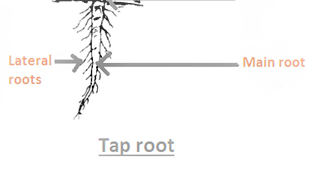
- In monocotyledonous plants, the primary root is short lived and is replaced by a large number of roots. These roots originate from the base of the stem and constitute the fibrous root system, as seen in the wheat plant.
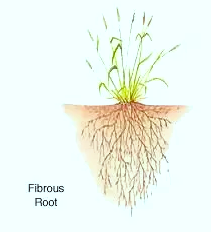
- In some plants, like grass, Monstera and the banyan tree, roots arise from parts of the plant other than the radicle and are called adventitious roots.

- The main functions of the root system are absorption of water and minerals from the soil, providing a proper anchorage to the plant parts, storing reserve food material and synthesis of plant growth regulators Regions of the Root.
Regions of the Root
- The root is covered at the apex by a thimble-like structure called the root cap.

- It protects the tender apex of the root as it makes its way through the soil.
- A few millimetres above the root cap is the region of meristematic activity. The cells of this region are very small, thin-walled and with dense protoplasm. They divide repeatedly.
- The cells proximal to this region undergo rapid elongation and enlargement and are responsible for the growth of the root in length. This region is called the region of elongation.
- The cells of the elongation zone gradually differentiate and mature. Hence, this zone, proximal to region of elongation, is called the region of maturation.
- From this region some of the epidermal cells form very fine and delicate, thread-like structures called root hairs.
- These root hairs absorb water and minerals from the soil.
Modifications of Root
- Roots in some plants change their shape and structure and become modified to perform functions other than absorption and conduction of water and minerals. They are modified for support, storage of food and respiration.



- Tap roots of carrot, turnip and adventitious roots of sweet potato, get swollen and store food hanging structures that support a banyan tree are called prop roots.
- Similarly, the stems of maize and sugarcane have supporting roots coming out of the lower nodes of the stem. These are called stilt roots.
- In some plants such as Rhizophora growing in swampy areas, many roots come out of the ground and grow vertically upwards.
- Such roots, called pneumatophores, help to get oxygen for respiration.

1. The roots that originate from the base of the stem are (NCERT Page-66, Phase-II, 2020)
(a) Primary roots
(b) Prop roots
(c) Lateral roots
(d) Fibrous roots
2. Pneumatophores occur in (NCERT Page-67, 2018)
(a) Halophytes
(b) Free-floating hydrophytes
(c) Submerged hydrophytes
(d) Carnivorous plants
3. Plants which produce characteristic pneumatophores and show vivipary belong to: (2017)
(a) Halophytes
(b) Psammophytes
(c) Hydrophytes
(d) Mesophytes
4. Sweet potato is homologous to (2011 M)
(a) Potato
(b) Colocasia
(c) Ginger
(d) Turnip
5. Roots of which plant contains an oxidizing agent? (2001)
(a) Carrot
(b) Soyabean
(d) Mustard
(d) Radish
6. Pneumatophores are characteristic of plants growing in (NCERT Page-67, 2000)
(a) saline soils
(b) sandy soils
(c) marshy places and salt lakes
(d) dryland regions
7. The plant, which bears clinging roots, is (1999)
(a) trapa
(b) orchid
(c) screw pine
(d) podostemon
8. Buttress roots are found in (1995)
(a) sorghum
(b) banyan
(c) Terminalia
(d) Pandanus
9. Velamen is found in (1991)
(a) roots of Screwpine
(b) aerial and terrestrial roots of orchids
(c) leaves of Ficus elastica
(d) aerial roots of orchids
The Stem
- The stem is the ascending part of the axis bearing branches, leaves, flowers and fruits. It develops from the plumule of the embryo of a germinating seed. The stem bears nodes and internodes.
- The region of the stem where leaves are born are called nodes while internodes are the portions between two nodes.
- The stem bears buds, which may be terminal or axillary. Stem is generally green when young and later often become woody and dark brown.
- The main function of the stem is spreading out branches bearing leaves, flowers and fruits. It conducts water, minerals and photosynthates. Some stems perform the function of storage of food, support, protection and of vegetative propagation
Modifications of Stem
- The stem may not always be typically like what they are expected to be. They are modified to perform different functions.
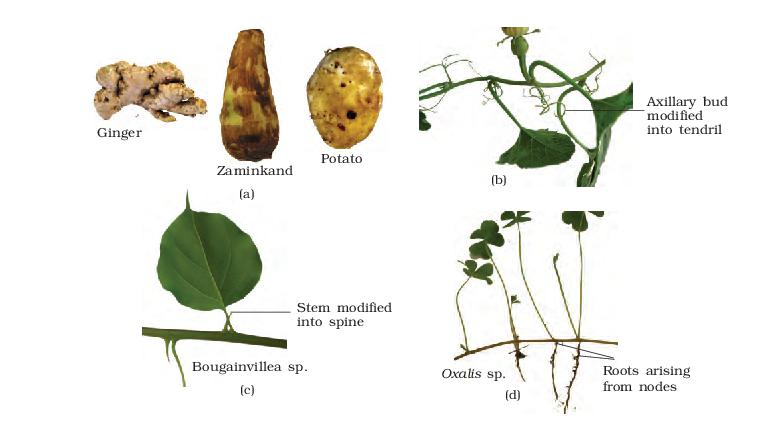
- Underground stems of potato, ginger, turmeric, zaminkand, Colocasia are modified to store food in them.
- They also act as organs of perennation to tide over conditions unfavourable for growth
- Stem tendrils which develop from axillary buds, are slender and spirally coiled and help plants to climb such as in gourds (cucumber, pumpkins, watermelon) and grapevines.
- Axillary buds of stems may also get modified into woody, straight and pointed thorns.
- Thorns are found in many plants such as Citrus, Bougainvillea.
- They protect plants from browsing animals.
- Some plants of arid regions modify their stems into flattened (Opuntia), or fleshy cylindrical (Euphorbia) structures.
- Underground stems of some plants such as grass and strawberry, etc., spread to new niches and when older parts die new plants are formed.
- In plants like mint and jasmine a slender lateral branch arises from the base of the main axis and after growing aerially for some time arch downwards to touch the ground.
- A lateral branch with short internodes and each node bearing a rosette of leaves and a tuft of roots is found in aquatic plants like Pistia and Eichhornia
- In banana, pineapple and Chrysanthemum, the lateral branches originate from the basal and underground portion of the main stem, grow horizontally beneath the soil and then come out obliquely upward giving rise to leafy shoots.
10. Identify the correct set of statements: (NCERT, Page-68, 2022)
(i) The leaflets are modified into pointed hard thorns in Citrus and Bougainvillea
(ii) Axillary buds form slender and spirally coiled tendrils in cucumber and pumpkin
(iii) Stem is flattened and fleshy in Opuntia and modified to perform the function of leaves
(iv) Rhizophora shows vertically upward growing roots that help to get oxygen for respiration
(v) Subaerially growing stems in grasses and strawberry help in vegetative propagation
Choose the correct answer from the options given below:
(a) (i) and (iv) Only
(b) (ii), (iii),(iv) and (v) Only
(c) (i), (ii), (iv) and (v) Only
(d) (ii) and (iii) Only
11. In Bougainvillea thorns are the modifications of: (NCERT, Page-68, 2017)
(a) Adventitious root
(b) Stem
(c) Leaf
(d) Stipules
12. Which of the following is not a stem modification? (NCERT, Page-68, 2016)
(a) Pitcher of Nepenthes
(b) Thorns of citrus
(c) Tendrils of cucumber
(d) Flattened structures of Opuntia
13. An example of edible underground stem is: (NCERT, Page-68 2014)
(a) Carrot
(b) Groundnut
(c) Sweet potato
(d) Potato
14. What is eye of potato? (NCERT, Page-68, 2001)
(a) Axillary bud
(b) Accessory bud
(c) Adventitious bud
(d) Apical bud
The Leaf
- The leaf is a lateral, generally flattened structure borne on the stem. It develops at the node and bears a bud in its axil.
- The axillary bud later develops into a branch. Leaves originate from shoot apical meristems and are arranged in an acropetal order. They are the most important vegetative organs for photosynthesis
- A typical leaf consists of three main parts: leaf base, petiole and lamina.

- The leaf is attached to the stem by the leaf base and may bear two lateral small leaf like structures called stipules.
- In monocotyledons, the leaf base expands into a sheath covering the stem partially or wholly.
- In some leguminous plants the leaf base may become swollen, which is called the pulvinus.
- The petiole help hold the blade to light. Long thin flexible petioles allow leaf blades to flutter in wind, thereby cooling the leaf and bringing fresh air to leaf surface
- The lamina or the leaf blades is the green expanded part of the leaf with veins and veinlets a middle prominent vein, which is known as the midrib.
- Veins provide rigidity to the leaf blade and act as channels of transport for water, minerals and food materials.
- The shape, margin, apex, surface and extent of incision of lamina varies in different leaves
Venation
- The arrangement of veins and the veinlets in the lamina of leaf is termed as venation.
- When the veinlets form a network, the venation is termed as reticulate.
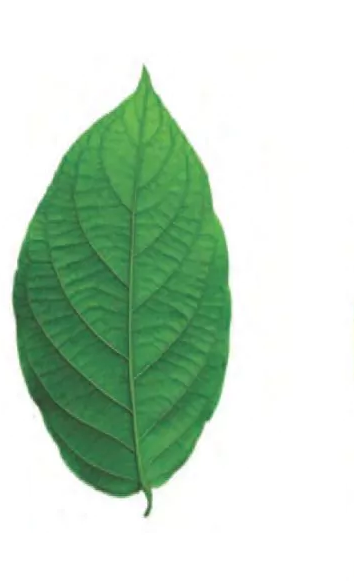
- When the veins run parallel to each other within a lamina, the venation is termed as parallel.
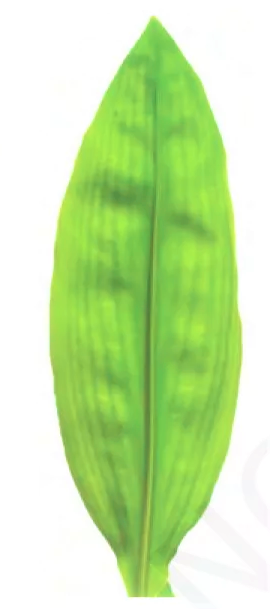
- Leaves of dicotyledonous plants generally possess reticulate venation, while parallel venation is the characteristic of most monocotyledons.
Types of Leaves
- A leaf is said to be simple, when its lamina is entire or when incised, the incisions do not touch the midrib.
- When the incisions of the lamina reach up to the midrib breaking it into a number of leaflets, the leaf is called compound.
- A bud is present in the axil of petiole in both simple and compound leaves, but not in the axil of leaflets of the compound leaf
- The compound leaves may be of two types-
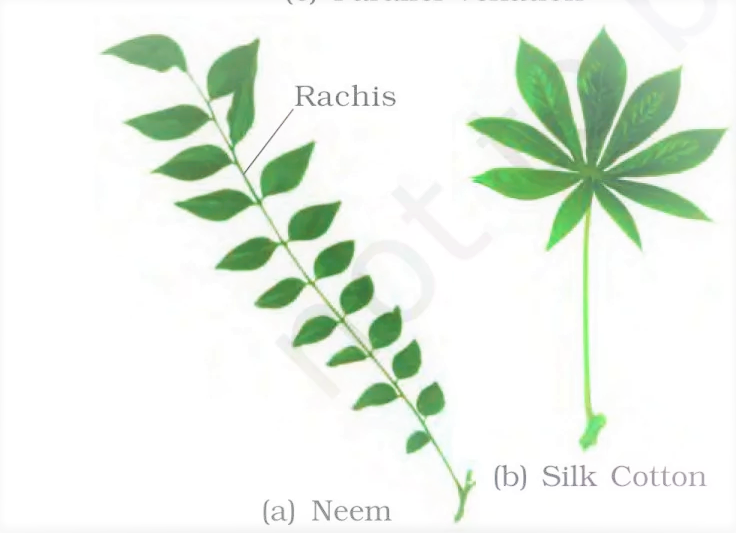
- In a pinnately compound leaf a number of leaflets are present on a common axis, the rachis, which represents the midrib of the leaf as in neem.
- In palmately compound leaves, the leaflets are attached at a common point, i.e., at the tip of petiole, as in silk cotton.
Phyllotaxy
- Phyllotaxy is the pattern of arrangement of leaves on the stem or branch. This is usually of three types - alternate, opposite and whorled·

- In alternate type of phyllotaxy, a single leaf arises at each node in alternate manner, as in china rose, mustard and sun flower plants
- In opposite type, a pair of leaves arise at each node and lie opposite to each other as in Calotropis and guava plants.
- If more than two leaves arise at a node and form a whorl, it is called whorled, as in Alstonia.
Modifications of Leaves
- Leaves are often modified to perform functions other than photosynthesis
- They are converted into tendrils for climbing as in peas or into spines for defence as in cacti.
- The fleshy leaves of onion and garlic store food
- In some plants such as Australian acacia, the leaves are small and short-lived.
- The petioles in these plants expand, become green and synthesis food.
- Leaves of certain insectivorous plants such as pitcher plant, venus-fly trap are also modified leaves.
15. Stems modified into flat green organs performing the functions of leaves are known as (2016)
(a) Cladodes
(b) Phyllodes
(c) Phylloclades
(d) Scales
16. Leaves become modified into spines in: (NCERT, Page-71, 2015 RS)
(a) Pea
(b) Onion
(c) Silk Cotton
(d) Opuntia
17. How many plants among China rose, Ocimum, sunflower, mustard, Alstonia, guava, Calotropis and Nerium (Oleander) have opposite phyllotaxy? (NCERT Page-71, Kar, 2013)
(a) Two
(b) Three
(c) Four
(d) Five
18. Phyllode is present in (2012)
(a) Asparagus
(b) Euphorbia
(c) Australian Acacia
(d) Opuntia
19. Whorled, simple leaves with reticulate venation are present in (2011 M)
(a) Calotropis
(b) Neem
(c) China rose
(d) Alstonia
20. Heterospory and seed habit are often discussed in relation to a structure called (1997)
(a) spathe
(b) bract
(c) petiole
(d) ligule
The Inflorescence
- A flower is a modified shoot wherein the shoot apical meristem changes to floral meristem.
- Internodes do not elongate and the axis gets condensed.
- The apex produces different kinds of floral appendages laterally at successive nodes instead of leaves.
- When a shoot tip transforms into a flower, it is always solitary.
- The arrangement of flowers on the floral axis is termed as inflorescence.
- Depending on whether the apex gets converted into a flower or continues to grow, two major types of inflorescences are defined-racemose and cymose.
- In racemose type of inflorescences the main axis continues to grow, the flowers are borne laterally in an acropetal succession.

- In cymose type of inflorescence the main axis terminates in a flower, hence is limited in growth. The flowers are borne in a basipetal order.

The Flower
- The flower is the reproductive unit in the angiosperms
- It is meant for sexual reproduction.
- A typical flower has four different kinds of whorls arranged successively on the swollen end of the stalk or pedicel, called thalamus or receptacle.
- These are calyx, corolla, androecium and gynoecium.
- Calyx and corolla are accessory organs, while androecium and gynoecium are reproductive organs.
- In some flowers like lily, the calyx and corolla are not distinct and are termed as perianth.
- When a flower has both androecium and gynoecium, it is bisexual. A flower having either only stamens or only carpels is unisexual.
- In symmetry, the flower may be actinomorphic (radial symmetry) or zygomorphic (bilateral symmetry)
- When a flower can be divided into two equal radial halves in any radial plane passing through the centre, it is said to be actinomorphic, e.g., mustard, datura, chilli.
- When it can be divided into two similar halves only in one particular vertical plane, it is zygomorphic, e.g., pea, gulmohur, bean, Cassia.
- A flower is asymmetric (irregular) if it cannot be divided into two similar halves by any vertical plane passing through the centre, as in canna
- A flower may be trirnerous, tetramerous or pentamerous when the floral appendages are in multiple of 3, 4 or 5, respectively
- Flowers with bracts-reduced leaf found at the base of the pedicel - are called bracteate and those without bracts, ebracteate.
- Based on the position of calyx, corolla and androecium in respect of the ovary on thalamus, the flowers are described as hypogynous, perigynous and epigynous

- In the hypogynous flower the gynoecium occupies the highest position while the other parts are situated below it.
- The ovary in such flowers is said to be superior, e.g., mustard, china rose and brinjal
- If gynoecium is situated in the centre and other parts of the flower are located on the rim of the thalamus almost at the same level, it is called perigynous
- The ovary here is said to be half inferior, e.g., plum, rose, peach.
- In epigynous flowers, the margin of thalamus grows upward enclosing the ovary completely and getting fused with it, the other parts of flower arise above the ovary the ovary is said to be inferior as in flowers of guava and cucumber, and the ray florets of sunflower.
Parts of a Flower
- Each flower normally has four floral whorls, viz., calyx, corolla, androecium and gynoecium.

Calyx
- The calyx is the outermost whorl of the flower and the members are called sepals. Generally, sepals are green, leaf like and protect the flower in the bud stage. The calyx may be gamosepalous (sepals united) or polysepalous (sepals free).
Corolla
- Corolla is composed of petals. Petals are usually brightly coloured to attract insects for pollination. Like calyx, corolla may be also united gamopetalous (petals united) or polypetalous (petals free).
- The shape and colour of corolla vary greatly in plants. Corolla may be tubular, bellshaped, tunnel-shaped or wheel-shaped
Aestivation:
- The mode of arrangement of sepals or petals in floral bud with respect to the other members of the same whorl is known as aestivation
- The main types of aestivation are valvate, twisted, imbricate and Vexillary

- When sepals or petals in a whorl just touch one another at the margin, without overlapping, as in Calotropis, it is said to be Valvate
- If one margin of the appendage overlaps that of the next one and so on as in china rose, lady’s finger and cotton, it is called twisted
- If the margins of sepals or petals overlap one another but not in any particular direction as in Cassia and gulmohur, the aestivation is called imbricate
- In pea and bean flowers, there are five petals, the largest (standard) overlaps the two lateral petals (wings) which in turn overlap the two smallest anterior petals (keel); this type of aestivation is known as vexillary or papilionaceous
Androecium
- Androecium is composed of stamens. Each stamen which represents the male reproductive organ consists of a stalk or a filament and an anther
- Each anther is usually bilobed and each lobe has two chambers, the pollen-sacs.
- The pollen grains are produced in pollen-sacs. A sterile stamen is called staminode
- Stamens of flower may be united with other members such as petals or among themselves
- When stamens are attached to the petals, they are epipetalous as in brinjal, or epiphyllous when attached to the perianth as in the flowers of lily
- The stamens in a flower may either remain free (polyandrous) or may be united in varying degrees
- The stamens may be united into one bunch or one bundle (monoaderphous) as in china rose, or two bundles (diadelphous) as in pea, or into more than two bundles (polyadelphous) as in citrus.
- There may be a variation in the length of filaments within a flower, as in Salvia and mustard.
Gynoecium
- Gynoecium is the female reproductive part of the flower and is made up of one or more carpels
- A carpel consists of three parts namely stigma, style and ovary.
- Ovary is the enlarged basal part, on which lies the elongated tube, the style. The style connects the ovary to the stigma.
- The stigma is usually at the tip of the style and is the receptive surface for pollen grains
- Each ovary bears one or more ovules attached to a flattened, cushion-like placenta
- When more than one carpel is present, they may be free (as in lotus and rose) and are called apocarpous
- They are termed syncarpous when carpels are fused, as in mustard and tomato. After fertilisation, the ovules develop into seeds and the ovary matures into a fruit
Placentation
- The arrangement of ovules within the ovary is known as placentation
- The placentation are of different types namely, marginal, axile, parietal, basal, central and free central.

- In marginal placentation the placenta forms a ridge along the ventral suture of the ovary and the ovules are borne on this ridge forming two rows, as in pea.
- When the placenta is axial and the ovules are attached to it in a multilocular ovary, the placentaion is said to be axile, as in china rose, tomato and lemon.
- In parietal placentation, the ovules develop on the inner wall of the ovary or on peripheral part.
- Ovary is one-chambered but it becomes two chambered due to the formation of the false septum, e.g., mustard and Argemone.
- When the ovules are borne on central axis and septa are absent, as in Dianthus and Primrose the placentation is called free central.
- In basal placentation, the placenta develops at the base of ovary and a single ovule is attached to it, as in sunflower, marigold.
21. The flowers are Zygomorphic in: (NCERT, Page-72, 2022)
(i) Mustard
(ii) Gulmohar
(iii) Cassia
(iv) Datura
(v) Chilly
Choose the correct answer from the options given below:
(a) (ii), (iii) Only
(b) (iv), (v) Only
(c) (iii), (iv), (v) Only
(d) (i), (ii), (iii) Only
22. Which one of the following plants shows vexillary aestivation and diadelphous stamens? (NCERT, Page-75, 2022)
(a) Pisum sativum
(b) Allium cepa
(c) Solanum nigrum
(d) Colchicum autumnale
23. Diadelphous stamens are found in (NCERT, Page-75, 2021)
(a) China rose and citrus
(b) China rose
(c) Citrus
(d) Pea
24. Ray florets have (NCERT, Page-73, 2020)
(a) Superior ovary
(b) Hypogynous ovary
(c) Half inferior ovary
(d) Inferior ovary
25. The ovary is half inferior in: (NCERT, Page-73, 2020, 2010)
(a) Mustard
(b) Sunflower
(c) Plum
(d) Brinjal
26. Match the placental types (column-I) with their examples (column-II). (NCERT, Page-75 & 46, 2019)
Column-I Column-II
(A) Basal (i) Mustard
(B) Axile (ii) China rose
(C) Parietal (iii) Dianthus
(D) Free central (iv) Sunflower
Choose the correct answer from the following options:
(a) (A)-(iii), (B)-(iv), (C)-(i), (D)-(ii)
(b) (A)-(ii), (B)-(iii), (C)-(iv), (D)-(i)
(c) (A)-(i), (B)-(ii), (C)-(iii), (D)-(iv)
(d) (A)-(iv), (B)-(ii), (C)-(i), (D)-(iii)
27. Placentation, in which ovules develop on the inner wall of the ovary or in peripheral part, is: (NCERT, Page-75, 2019)
(a) Basal
(b) Axile
(c) Parietal
(d) Free central
28. The standard petal of a papilionaceous corolla is also called (2016)
(a) Carina
(b) Pappus
(c) Vexillum
(d) Corona
29. Proximal end of the filament of stamen is attached to the (2016)
(a) Anther
(b) Connective
(c) Placenta
(d) Thalamus or petal
30. Perigynous flowers are found in : (NCERT, Page-73, 2015 RS)
(a) Cucumber
(b) China rose
(c) Rose
(d) Guava
31. Axile placentation is present in (NCERT, Page-75, 2015 RS, 2009)
(a) Lemon
(b) Pea
(c) Argemone
(d) Dianthus
32. When the margins of sepals or petals overlap one another without any particular direction, the condition is termed as: (NCERT, Page-74, 2014)
(a) Vexillary
(b) Imbricate
(c) Twisted
(d) Valvate
33. Among bitter gourd, mustard, brinjal, pumpkin, china rose, lupin, cucumber, sunhemp, gram, guava, bean, chilli, plum, petunia, tomato, rose, withania, potato, onion, aloe and tulip how many plants have hypogynous flower? (NCERT, Page-73, 2013)
(a) Ten
(b) Fifteen
(c) Eighteen
(d) Six
34. Among flowers of Calotropis, tulip, Sesbania, Asparagus, Colchicine, Sweet pea, Petunia, Indigofera, Mustard, Soyabean, Tobacco and groundnut how many plants have corolla with valvate aestivation? (2013)
(a) Five
(b) Six
(c) Seven
(d) Eight
35. In a cymose inflorescence the main axis (NCERT, Page-72, 2013)
(a) Terminates in a flower
(b) Has unlimited growth
(c) Bears a solitary flower
(d) Has unlimited growth but lateral branches end in flowers
36. Placentation in tomato and lemon is (NCERT, Page-75, 2012)
(a) Parietal
(b) Free central
(c) Marginal
(d) Axile
37. The gynoecium consists of many free pistils in flowers of (2012)
(a) Aloe
(b) Tomato
(c) Papaver
(d) Michelia
38. Flowers are zygomorphic in: (NCERT, Page-72, 2011 M)
(a) mustard
(b) gulmohur
(c) tomato
(d) datura
39. Which one of the following diagrams represents the placentation in Dianthus? (NCERT, Page-75, 2011 M)

40. The ovary is half inferior in flowers of (2011)
(a) peach
(b) cucumber
(c) cotton
(d) guava
41. In unilocular ovary with a single ovule the placentation is: (2010)
(a) Marginal
(b) Basal
(c) Free Central
(d) Axile
42. The technical term used for the androecium in a flower of China rose (Hibiscus rosa sinensis) is: (NCERT, Page-75, 2010 M)
(a) Monadelphous
(b) Diadelphous
(c) Polyandrous
(d) Polyadelphous
43. Replum is present in the ovary of flower of (2008)
(a) Lemon
(b) Mustard
(c) Sun flower
(d) Pea
44. What type of placentation is seen in sweet pea? (2006)
(a) Axile
(b) Free central
(c) Marginal
(d) Basal
45. Long filamentous threads protruding at the end of the young cob of maize are (2000, 06)
(a) styles
(b) ovaries
(c) hairs
(d) anthers
46. The type of placentation in which ovary is syncarpous, unilocular and ovules on sutures is called (NCERT, Page-75 1999)
(a) apical placentation
(b) parietal placentation
(c) marginal placentation
(d) superficial placentation
47. Floral features are chiefly used in Angiosperms identification because (1998)
(a) flowers are of various colours
(b) flowers can be safely pressed
(c) reproductive parts are more stable and conservative than vegetative parts
(d) flowers are nice to work with
48 Hypanthodium is (1994)
(a) thalamus
(b) fruit
(c) inflorescence
(d) ovary
49. Epipetalous stamens with free filaments and fused anthers occur in (1991, 92)
(a) Asteraceae
(b) Solanaceae
(c) Liliaceae
(d) Poaceae
The Fruit
- The fruit is a characteristic feature of the flowering plants
- It is a mature or ripened ovary, developed after fertilisation. If a fruit is formed without fertilisation of the ovary, it is called a parthenocarpic fruit.
- Generally, the fruit consists of a wall or pericarp and seeds
- The pericarp may be dry or fleshy
- When pericarp is thick and fleshy, it is differentiated into the outer epicarp, the middle mesocarp and the inner endocarp.
- In mango and coconut, the fruit is known as a drupe.
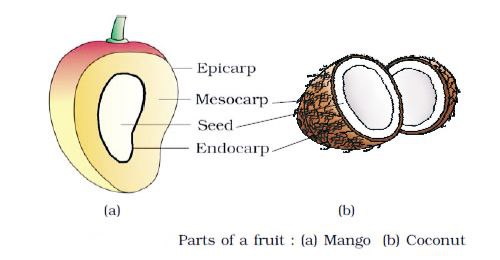
- They develop from monocarpellary superior ovaries and are one seeded.
- In mango the pericarp is well differentiated into an outer thin epicarp, a middle fleshy edible mesocarp and an inner stony hard endocarp
- In coconut which is also a drupe, the mesocarp is fibrous.
The Seed
- The ovules after fertilisation, develop into seeds.
- A seed is made up of a seed coat and an embryo. The embryo is made up of a radicle, an embryonal axis and one (as in wheat, maize) or two cotyledons (as in gram and pea
- Structure of a Dicotyledonous Seed.
- The outermost covering of a seed is the seed coat. The seed coat has two layers, the outer testa and the inner tegmen.
- The hilum is a scar on the seed coat through which the developing seeds were attached to the fruit.
- The hilum is a small pore called the micropyle.
- Within the seed coat is the embryo, consisting of an embryonal axis and two cotyledons. The cotyledons are often fleshy and full of reserve food materials.
- At the two ends of the embryonal axis are present the radicle and the plumule
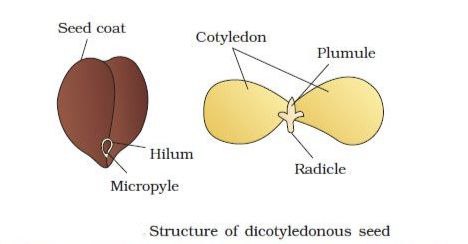
- In some seeds such as castor the endosperm formed as a result of double fertilisation, is a food storing tissue.
- In plants such as bean, gram and pea, the endosperm is not present in mature seeds and such seeds are called nonendospermous.
Structure of Monocotyledonous Seed
- Monocotyledonous seeds are endospermic but some as in orchids are non-endospermic
- In the seeds of cereals such as maize the seed coat is membranous and generally fused with the fruit wall
- The endosperm is bulky and stores food
- The outer covering of endosperm separates the embryo by a proteinous layer called aleurone layer.
- The embryo is small and situated in a groove at one end of the endosperm t consists of one large and shield shaped cotyledon known as scutellum and a short axis with a plumule and a radicle.
- The plumule and radicle are enclosed in sheaths which are called coleoptile and coleorhiza respectively.

50. Coconut fruit is a: (NCERT, Page-76, 2017)
(a) Berry
(b) Nut
(c) Capsule
(d) Drupe
51. The morphological nature of the edible part of coconut is: (2017)
(a) Cotyledon
(b) Endosperm
(c) Pericarp
(d) Perisperm
52. The coconut water from tender coconut represents (2016, 2015 RS)
(a) endocarp
(b) fleshy mesocarp
(c) free nuclear proembryo
(d) free nuclear endosperm
53. Cotyledon of maize grain is called (NCERT, Page-77, 2016)
(a) plumule
(b) coleorhiza
(c) coleoptile
(d) scutellum
54. Which one of the following fruits is parthenocarpic? (2015 RS)
(a) Apple
(b) Jackfruit
(c) Banana
(d) Brinjal
55. The wheat grain has an embryo with one, large, shield-shaped cotyledon known as: (2015 RS)
(a) Coleorrhiza
(b) Scutellum
(c) Coleoptile
(d) Epiblast
56. Placenta and pericarp are both edible portions in: (2014)
(a) Apple
(b) Banana
(c) Tomato
(d) Potato
57. Which one of the following statements is correct? (NCERT, Page-77, 2014)
(a) The seed in grasses is not endospermic.
(b) Mango is a parthenocarpic fruit.
(c) A proteinaceous aleurone layer is present in maize grain.
(d) A sterile pistil is called a staminode.
58. An aggregate fruit is one which develops from: (2014)
(a) Multicarpellary syncarpous gynoecium
(b) Multicarpellary apocarpus gynoecium
(c) Complete inflorescence
(d) Multicarpellary superior ovary
59. How many plants in the list given below have composite fruits that develop from an inflorescence: Walnut, poppy, radish, fig, pineapple, apple, tomato, mulberry (2012)
(a) Four
(b) Five
(c) Two
(d) Three
60. The coconut water and the edible part of coconut are equivalent to: (NCERT, Page-76, 2012)
(a) Endosperm
(b) Endocarp
(c) Mesocarp
(d) Embryo
61. Which one of the following statements is correct? (2011)
(a) In tomato, fruit is a capsule
(b) Seeds of orchids have oil-rich endosperm
(c) Placentation in primose is basal
(d) Flower of tulip is a modified shoot
62. What would be the number of chromosomes of the aleurone cells of a plant with 42 chromosomes in its root tip cells? (2010 M)
(a) 42
(b) 63
(c) 84
(d) 21
63. In a cereal grain the single cotyledon of embryo is represented by (NCERT, Page-77, 2006)
(a) scutellum
(b) prophyll
(c) coleoptile
(d) coleorhiza
64. Pineapple (ananas) fruit develops from (2006)
(a) a multipistillate syncarpous flower
(b) a cluster of compactly borne flowers on a common axis
(c) a multilocular monocarpellary flower
(d) a unilocular polycarpellary flower
65. Aril represents the edible part of (1997, 99, 2005, 06)
(a) banana
(b) litchi
(c) mango
(d) apple
66. Mango juice is got from (NCERT, Page-76, 1989, 2002, 04)
(a) epicarp
(b) mesocarp
(c) endocarp
(d) pericarp and thalamus
67. Juicy hair-like structures observed in the lemon fruit develop from (2003)
(a) mesocarp and endocarp
(b) exocarp
(c) mesocarp
(d) endocarp
68. The aleurone layer in maize grain is specially rich in (NCERT, Page-77, 2003)
(a) auxins
(b) proteins
(c) starch
(d) lipids
69. Edible part of banana is (2001)
(a) epicarp
(b) mesocarp and less developed endocarp
(c) endocarp and less developed mesocarp
(d) epicarp and mesocarp
70. Which is correct pair for edible part? (2001)
(a) Tomato - Thalamus
(b) Maize - Cotyledons
(c) Guava - mesocarp
(d) Date palm - Mesocarp
71. The embryo in sunflower has (NCERT, Page-76 &77, 1998)
(a) one cotyledon
(b) two cotyledons
(c) many cotyledons
(d) no cotyledon
72. Which one of the following statements is correct with respect to the plant species and its use? (1997)
(a) Oryza sativa - rich source of protein
(b) Manihot utilissima - root tubers eaten especially in Kerala
(c) Ricinus communis - important edible cereal
(d) Hibiscus esculentus - flowers eaten throughout the country.
73. Which one of the following is a true fruit? (1996)
(a) Apple
(b) Pear
(c) Cashew nut
(d) Coconut
74. Which part of the coconut produces coir? (NCERT, Page-76, 1996)
(a) Seed coat
(b) Mesocarp
(c) Epicarp
(d) Pericarp
75. Vivipary is (1992)
(a) seed germination with subterranean cotyledons
(b) seed germination with epiterranean cotyledons
(c) fruit development without pollination
(d) seed germination inside the fruit while attached to the plant
76. Germination of seed within fruit is (1992)
(a) ovipary
(b) vivipary
(c) hypogeal
(d) epigeal
77. Fruit of Mangifera indica is (NCERT, Page-76, 1991)
(a) Berry
(b) Drupe
(c) Capsule
(d) Siliqua
78. In Groundnut the food/oil reserve is present in (1990)
(a) epicarp
(b) mesocarp
(c) endosperm
(d) cotyledons
79. Perisperm is (1988, 89)
(a) remnant of endosperm
(b) persistent nucellus
(c) peripheral part of endosperm
(d) disintegrated secondary nucleus
80. Fruit of Groundnut is (1988)
(a) Legume
(b) Caryopsis
(c) Berry
(d) Nut
Semi-Technical Description of a Typical Flowering Plant
Various morphological features are used to describe a flowering plant. The description has to be brief, in a simple and scientific language and presented in a proper sequence. The plant is described beginning with its habit, vegetative characters – roots, stem and leaves and then floral characters inflorescence and flower parts. After describing various parts of plant, a floral diagram and a floral formula are presented.


Figure 5.20 Floral diagram with floral formula
The floral formula is represented by some symbols. In the floral formula, Br stands for bracteate K stands for calyx , C for corolla, P for perianth, A for androecium and G for Gynoecium, G for superior ovary and

for zygomorphic nature of flower. Fusion is indicated by enclosing the figure within bracket and adhesion by a line drawn above the symbols of the floral parts. A floral diagram provides information about the number of parts of a flower, their arrangement and the relation they have with one another (Figure 5.20). The position of the mother axis with respect to the flower is represented by a dot on the top of the floral diagram. Calyx, corolla, androecium and gynoecium are drawn in successive whorls, calyx being the outermost and the gynoecium being in the centre. Floral formula also shows cohesion and adhesion within parts of whorls and between whorls. The floral diagram and floral formula in Figure 5.20 represents the mustard plant (Family: Brassicaceae).
Description of Some Important Families
Fabaceae
This family was earlier called Papilionoideae, a subfamily of family Leguminosae. It is distributed all over the world (Figure 5.21).
Vegetative Characters
Trees, shrubs, herbs; root with root nodules
Stem: erect or climber
Leaves: alternate, pinnately compound or simple; leaf base, pulvinate; stipulate; venation reticulate.

Floral characters
Inflorescence: racemose
Flower: bisexual, zygomorphic
Calyx: sepals five, gamosepalous; valvate/imbricate aestivation
Corolla: petals five, polypetalous, papilionaceous, consisting of a posterior standard, two lateral wings, two anterior ones forming a keel (enclosing stamens and pistil), vexillary aestivation3
Androecium: ten, diadelphous, anther dithecous
Gynoecium: ovary superior, mono carpellary, unilocular with many ovules, style single
Fruit: legume; seed: one to many, non-endospermic
Floral formula: %

K(5) C1+2+(2) A(9)+1 G1
Economic importance
Many plants belonging to the family are sources of pulses (gram, arhar, sem, moong, soyabean; edible oil (soyabean, groundnut); dye (Indigofera); fibres (sunhemp); fodder (Sesbania, Trifolium), ornamentals (lupin, sweet pea); medicine (muliathi).
Solanaceae
It is a large family, commonly called as the ‘potato family’. It is widely distributed in tropics, subtropics and even temperate zones (Figure 5.22).
Vegetative Characters
Plants mostly herbs, shrubs and rarely small trees
Stem: herbaceous rarely woody, aerial; erect, cylindrical, branched, solid or hollow, hairy or glabrous, underground stem in potato (Solanum tuberosum)

Leaves: alternate, simple, rarely pinnately compound, exstipulate; venation reticulate
Floral Characters
Inflorescence : Solitary, axillary or cymose as in Solanum
Flower: bisexual, actinomorphic
Calyx: sepals five, united, persistent, valvate aestivation
Corolla: petals five, united; valvate aestivation
Androecium: stamens five, epipetalous
Gynoecium: bicarpellary obligately placed, syncarpous; ovary superior, bilocular, placenta swollen with many ovules, axile4
Fruits: berry or capsule
Seeds: many, endospermous
Floral Formula:

Economic Importance
Many plants belonging to this family are source of food (tomato, brinjal, potato), spice (chilli); medicine (belladonna, ashwagandha); fumigatory (tobacco); ornamentals (petunia).
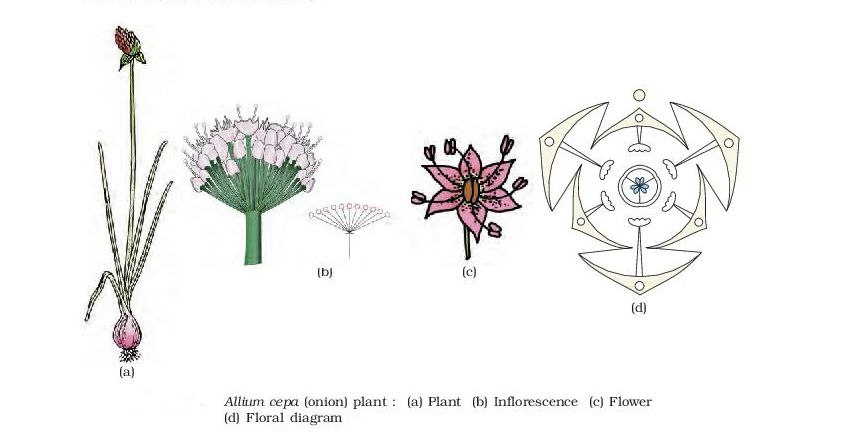
5.9.3 Liliaceae
Commonly called the ‘Lily family’ is a characteristic representative of monocotyledonous plants. It is distributed world wide (Figure 5.23).
Vegetative characters: Perennial herbs with underground bulbs/corms/rhizomes
Leaves mostly basal, alternate, linear, exstipulate with parallel venation
Floral characters
Inflorescence: solitary / cymose; often umbellate clusters
Flower: bisexual; actinomorphic
Perianth tepal six (3+3), often united into tube; valvate aestivation
Androecium: stamen six, 3+3, epitepalous
Gynoecium: tricarpellary, syncarpous, ovary superior, trilocular with many ovules; axile placentation3
Fruit: capsule, rarely berry
Seed: endospermous
Floral Formula:5 Br

P(3+3) A3+3 G(3)
Economic Importance
Many plants belonging to this family are good ornamentals (tulip, Gloriosa), source of medicine (Aloe), vegetables (Asparagus), and colchicine (Colchicum autumnale).
Tips/Tricks/Techniques ONE-Liners
(Exam Special)
- Rachis- In plants, a rachis is the main axis of a compound structure. It can be the main stem of a compound leaf, such as in Acacia or ferns, or the main, flower-bearing portion of an inflorescence above a supporting peduncle.
- Epipetalous- When stamens are attached to the petals, as in brinjal.
- Epiphyllous- When stamens are attached to the perianth as in the flowers of lily.
- Gladiolus is an example of corm.
- Opunlia and Ephorbia are example of phylloclade.
- In Nepenthes, only lamina is modified into pitcher like structure.
- In Achlamydeous flower, accessory whorls are absent.
- In Portulaca food storing adventitious root is present.
81. Match Column-I with Column-II. (NCERT Page-79, 80 & 81, 2021)
Select the correct answer from the options given below.
(A) (B) (C) (D)
(a) (iv) (ii) (i) (iii)
(b) (iii) (iv) (ii) (i)
(c) (i) (ii) (iii) (iv)
(d) (ii) (iii) (iv) (i)
82. Which of the following is the correct floral formula of Liliaceae? (NCERT, Page-81, Phase-II, 2020)

85.

is the floral formula of (NCERT, Page-80, 2015 RS)
(a) Sesbania
(b) Petunia
(c) Brassica
(d) Allium
86. Keel is the characteristic feature of flower of: (NCERT, Page-78 & 79, 2015 RS)
(a) Indigofera
(b) Aloe
(c) Tomato
(d) Tulip
87. Among china rose, mustard, brinjal, potato, guava, cucumber, onion and tulip, how many plants have superior ovary? (NCERT, Page-80 & 81, 2015 RS)
(a) Six
(b) Three
(c) Four
(d) Five
88. Flowers are unisexual in: (2015 RS)
(a) Cucumber
(b) China rose
(c) Onion
(d) Pea
89. In china rose the flowers are: (Kar, 2013)
(a) Actinomorphic, epigynous with valvate aestivation
(b) Zygomorphic, hypogynous with imbricate aestivation
(c) Zygomorphic, epigynous with twisted aestivation
(d) Actinomorphic, hypogynous with twisted aestivation
90. Inflorescence is racemose in (NCERT, Page-79, 2013)
(a) Soyabean
(b) Brinjal
(c) Tulip
(d) Aloe
91. Vexillary aestivation is characteristic of the family. (NCERT, Page-79, 2012)
(a) Fabaceae
(b) Asteraceae
(c) Solanaceae
(d) Brassicaceae
92. Which one of the following organisms is correctly matched with its three characteristics? (NCERT, Page-81, 2012 M)
(a) Pea: C3 pathway, Endospermic seed, Vexillary aestivation
(b) Tomato: Twisted aestivation, Axile placentation, Berry
(c) Onion: Bulb, Imbricate aestivation, Axile placentation
(d) Maize: C3 pathway, Closed vascular bundles, Scutellum
93. Cymose inflorescence is present in : (NCERT, Page-80, 2012)
(a) Solanum
(b) Sesbania
(c) Trifolium
(d) Brassica
94. How many plants in the list given below have marginal placentation?
Mustard, Gram, Tulip, Asparagus, Arhar, Sun hemp, Chilli, Colchicine, Onion, Moong, Pea, Tobacco, Lupin (NCERT, Page-79, 2012 M)
(a) Four
(b) Five
(c) Six
(d) Three
95. The correct floral formula of chilli is: (NCERT, Page-80, 2011)

96. Keel is characteristic of the flowers of: (NCERT, Page-79, 2010)
(a) Gulmohur
(b) Cassia
(c) Calotropis
(d) Bean
97. The floral formula is that of: (NCERT, Page-80, 2010 M)

(a) Soyabean
(b) Sunhemp
(c) Tobacco
(d) Tulip
98. Pentamerous, actinomorphic flowers, bicarpellate ovary with oblique septa and fruit a capsule of berry, are characteristic features of (NCERT, Page-80, 2006)
(a) Brassicaceae
(b) Solanaceae
(c) Liliaceae
(d) Asteraceae
99. Bicarpellary gynoecium and oblique ovary occurs in (NCERT, Page-80, 2001)
(a) Mustard
(b) Banana
(c) Pisum
(d) Brinjal
100. Tetradynamous stamens are found in family (NCERT, Page-78, 1995, 01)
(a) Malvaceae
(b) Solanaceae
(c) Cruciferae
(d) Liliaceae
101. Match the following and indicate which is correct (2000)
(a) Cucurbitaceae - Orange
(b) Malvaceae - Cotton
(c) Brassicaceae - Wheat
(d) Leguminosae - Sunflower
102. Pulses are obtained from (NCERT, Page-78 & 79, 1993)
(a) Fabaceae
(b) Asteraceae
(c) Poaceae
(d) Solanaceae
103. Floral formula of Tomato/Tobacco is (NCERT, Page-80, 1989, 92)

104. Syngenesious condition is found in (1991)
(a) Asteraceae
(b) Labiate
(c) Solanaceae
(d) Fabaceae
105. Gillis floral formula of (NCERT, Page-80, 1991)
(a) Liliaccae
(b) Solanaceae
(c) Asteraceae
(d) Fabaceae
106. Botanical name of Cauliflower is (1991)
(a) Brassica oleracea var. capitata
(b) Brassica campesteris
(c) Brassica oleracea var. botrytis
(d) Brassica oleracea var. gemmifera
107. A family delimited by head type of inflorescence is (1990)
(a) Fabaceae
(b) Asteracea
(c) Solanaceae
(d) Liliaceae
| Question. No. | 1 | 2 | 3 | 4 | 5 | 6 | 7 | 8 | 9 |
| Answer | (d) | (a) | (a) | (d) | (b) | (c) | (b) | (c) | (d) |
| Question. No. | 10 | 11 | 12 | 13 | 14 |
| Answer | (b) | (b) | (a) | (d) | (a) |
| Question No. | 15 | 16 | 17 | 18 | 19 | 20 |
| Answer | (c) | (d) | (b) | (c) | (d) | (d) |
| Question No. | Answer |
| 21 | (a) |
| 22 | (a) |
| 23 | (d) |
| 24 | (d) |
| 25 | (c) |
| 26 | (d) |
| 27 | (c) |
| 28 | (c) |
| 29 | (d) |
| 30 | (c) |
| 31 | (a) |
| 32 | (b) |
| 33 | (b) |
| 34 | (c) |
| 35 | (a) |
| 36 | (d) |
| 37 | (d) |
| 38 | (b) |
| 39 | (c) |
| 40 | (a) |
| 41 | (b) |
| 42 | (a) |
| 43 | (b) |
| 44 | (c) |
| 45 | (a) |
| 46 | (c) |
| 47 | (c) |
| 48 | (c) |
| 49 | (a) |
| Question No. | Answer |
| 50 | (d) |
| 51 | (b) |
| 52 | (d) |
| 53 | (d) |
| 54 | (c) |
| 55 | (b) |
| 56 | (c) |
| 57 | (c) |
| 58 | (b) |
| 59 | (d) |
| 60 | (a) |
| 61 | (d) |
| 62 | (b) |
| 63 | (a) |
| 64 | (b) |
| 65 | (b) |
| 66 | (b) |
| 67 | (d) |
| 68 | (b) |
| 69 | (b) |
| 70 | (d) |
| 71 | (b) |
| 72 | (b) |
| 73 | (d) |
| 74 | (b) |
| 75 | (d) |
| 76 | (b) |
| 77 | (b) |
| 78 | (d) |
| 79 | (b) |
| 80 | (a) |
| Question No. | Answer |
| 81 | (b) |
| 82 | (d) |
| 83 | (d) |
| 84 | (a) |
| 85 | (b) |
| 86 | (a) |
| 87 | (a) |
| 88 | (a) |
| 89 | (d) |
| 90 | (a) |
| 91 | (a) |
| 92 | (c) |
| 93 | (a) |
| 94 | (c) |
| 95 | (b) |
| 96 | (d) |
| 97 | (c) |
| 98 | (b) |
| 99 | (d) |
| 100 | (c) |
| 101 | (b) |
| 102 | (a) |
| 103 | (d) |
| 104 | (a) |
| 105 | (b) |
| 106 | (c) |
| 107 | (b) |
… [Trackback]
[…] Find More on that Topic: eklabhyaclasses.com/blog/morphology-of-flowering-plant/ […]
… [Trackback]
[…] Read More Info here to that Topic: eklabhyaclasses.com/blog/morphology-of-flowering-plant/ […]
… [Trackback]
[…] Info on that Topic: eklabhyaclasses.com/blog/morphology-of-flowering-plant/ […]
The Illuminati brotherhood is an elite organisation of world leaders, business authorities, innovators, artists, and other influential members of this planet. Our coalition unites influencers of all political, religious, and geographical backgrounds to further the prosperity of the human species as a whole.
<ahref=”https://illuminatiofficialmembers.org/”>How To Join The Illuminati</a>
… [Trackback]
[…] Info on that Topic: eklabhyaclasses.com/blog/morphology-of-flowering-plant/ […]
… [Trackback]
[…] Read More Information here on that Topic: eklabhyaclasses.com/blog/morphology-of-flowering-plant/ […]